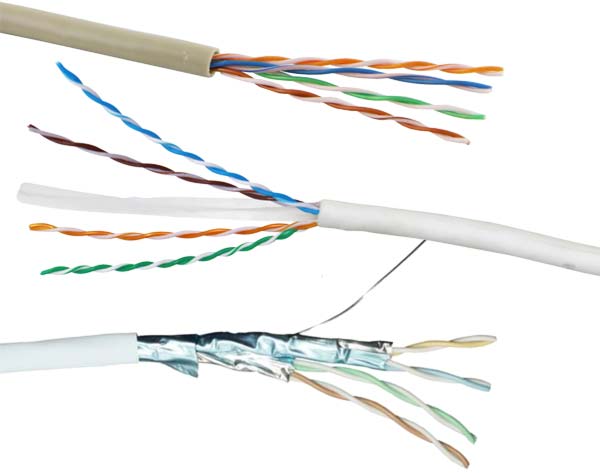Data Cabling
Abbey IP supply and install a range of data cabling including CAT 5, CAT 5e, CAT 6 and CAT 6a. We can also provide fibre terminations.
Data Cabling & Fibre Terminations
When it comes to data cables, it's easy to get lost in a world of data cable types, their uses, and the best data cables for the job. That is where we can help!
Not only will we supply and install your data cabling, we can advise you on what sort of cabling you should need for each application.
Ethernet Cabling
Cat-5 Ethernet Cabling: This network cable was widely used for 100Base-T and 1000Base-T networks as it provides performance to allow data at 100 Mbps. The Cat 5 cable superseded the Cat 3 version and for a number of years it became the standard for Ethernet cabling. Cat 5 cable is now considered outdated and therefore it is not really recomended. Cat 5 cable uses twisted pairs to prevent internal crosstalk.
Cat-5e Ethernet Cabling: Cat-5e can be used for 100Base-T and 1000Base-T (Gigabit Ethernet). Cat 5e stands for Cat 5 enhanced and it is a form of Cat 5 cable manufactured to higher specifications although its physically the same as Cat 5. It is tested to a higher specification to ensure it can perform at the higher data speeds. The twisted pairs within the network cables tend to have the same level of twisting as the Cat 5 cables.
Cat-6 Ethernet Cabling: This cable provides a significant improvement in performance over Cat 5 and Cat 5e. During manufacture Cat 6 cables are more tightly wound than either Cat 5 or Cat 5e and they often have an outer foil or braided shielding. The shielding protects the twisted pairs of wires inside the Ethernet cable, helping to prevent crosstalk and noise interference. Cat-6 cables can technically support speeds up to 10 Gbps.
Cat-6a Ethernet Cabling: The “a” in Cat 6a stands for “Augmented” and the standard was revised in 2008. The Cat 6a cables are able to support twice the maximum bandwidth, and are capable of maintaining higher transmission speeds over longer network cable lengths. Cat 6a cables utilise shielding which is sufficient to all but eliminate crosstalk. However this makes them less flexible than Cat 6 cable.
Cat-7 Ethernet Cabling: It comprises four individually shielded pairs inside an overall shield. It is aimed at applications where transmission of frequencies up to 600 Mbps is required.
 Ethernet Cables
Ethernet CablesFibre Terminations
Because of the Low loss, high bandwidth properties of fibre cable they can be used over greater distances than copper cables, in data networks this can be as much as 2km without the use of repeaters. Their light weight and small size also make them ideal for applications where running copper cables would be impractical, and by using multiplexors one fibre could replace hundreds of copper cables. This is pretty impressive for a tiny glass filament, but the real benefits in the data industry are its immunity to Electro Magnetic Interference (EMI), and the fact that glass is not an electrical conductor. Because fibre is non-conductive, it can be used where electrical isolation is needed, for instance between buildings where copper cables would require cross bonding to eliminate differences in earth potentials. Fibres also pose no threat in dangerous environments such as chemical plants where a spark could trigger an explosion.
 Fibre Cabling and Terminations
Fibre Cabling and Terminations